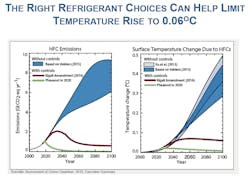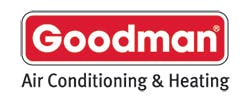Refrigerant Transition: How Did We Get Here and Where Are We Going?
Nope, Earth isn’t cooling. Carbon dioxide levels in the atmosphere have been rising steadily since the Industrial Age, contributing to global warming and putting the planet at risk. Independent research shows the role that HVAC plays in this equation: stationary air conditioning contributes nearly 20% of electrical consumption of buildings today, and the use of air conditioning is projected to triple by 2050.[i]
If we continue developing the world as is, without controls, temperatures are forecast to rise up to 0.6°C directly from HFC emissions. The good news, though, is that research shows that making the right refrigerant choices has the potential to limit the temperature rise due to HFC emissions to 0.06°C. That’s six one-hundredths of a degree.[ii] And that’s why our industry is striving for decarbonization and improved efficiency.
Previous policies, such as the Montreal Protocol, were designed to improve HVAC climate performance. The Protocol was adopted globally in 1989 to protect the ozone layer by eliminating the use of ozone depleting substances over time. High ozone depletion potential (ODP) chlorofluorocarbons (CFCs) were phased out in 1996, followed by lower ODP refrigerants which are still transitioning out. In October of 2016, more than 170 countries agreed to amend the Protocol. The Kigali Amendment was created to phase down hydrofluorocarbons (HFCs) by eliminating their consumption and production. Today’s common refrigerants like R-134A and R-410A are targeted in this phasedown. It’s time for the HVAC industry to transition to the next-generation refrigerants.
At Daikin, we are all working towards Daikin’s Environmental Policy to provide safe and healthy air to the world while striving for zero carbon dioxide emissions by 2050. We’ll continue to work collaboratively with consumers, standards and code bodies, industry associations, governments, regulators, and non-governmental organizations to provide for the use of next-generation refrigerants with reduced global warming potential. As the only manufacturer of both HVACR equipment and refrigerants, Daikin is in a unique position to holistically review any and all refrigerant options for the industry’s transition to next-generation refrigerants. Our approach has always been to use our expertise to choose the right refrigerant for each application.
We believe pure, single component R-32 is the most balanced and ideal refrigerant solution to replace R-410A for certain residential, light commercial, and applied applications. While the refrigerant’s lower GWP is an important component, an informed choice requires a holistic evaluation of the environmental impact, cost effectiveness, availability, recyclability, energy efficiency, safety, global experiences, and ease of handling. Our research shows that R-32 gives us the tools to design products that will outperform the current generation of R-410A products while also providing a better value for the building owner and a better outlook for our planet.
[i] International Energy Agency, “The Future of Cooling: Opportunities for Energy Efficient Air Conditioning,” 2018.
[ii] National Oceanic and Atmospheric Administration, “Scientific Assessment of Ozone Depletion,” 2018.
Check out R32reasons.com to learn why people all over the world are already using R-32 in over 100 million units!
Sponsored By:






